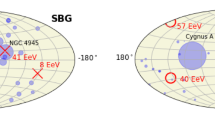Abstract
During the last decade, very high energy astrophysics emerged as a new branch of astronomy with major discoveries achieved by the present ground-based gamma-ray Cherenkov telescopes. The sample of cosmic sources firmly detected at very high energy (VHE) now exceeds two hundred objects, including active galactic nuclei (AGN), pulsar wind nebulae, and several other types of sources of which a significant number are unidentified ones. The scientific return from recent VHE data is particularly interesting for AGN science, shedding new light on particle acceleration and emission processes around supermassive black holes, and probing the intergalactic space by the analysis of VHE photons propagating from bright remote sources to the Earth. The perspectives of this research field are promising with new generation VHE instruments such as CTA, a project of open observatory at extreme energies at the horizon 2023, allowing a deep analysis of the sky in the highest part of the electromagnetic spectrum, from 20 GeV to 300 TeV.


















Similar content being viewed by others
References
Abdalla H. et al. 2017a, Gamma-ray blazar spectra with HESS II mono analysis: The case of PKS 2155-304 and PG 1553+113, A&A, 600, id.A89
Abdalla H. et al. 2017b, Characterizing the gamma-ray long-term variability of PKS 2155-304 with HESS and Fermi-LAT, A&A, 598, id.A39
Abdalla H. et al. 2017c, Measurement of the EBL spectral energy distribution using the VHE gamma-ray spectra of HESS blazars, A&A, 606, id.A59
Abdalla H. et al. 2018, HESS discovery of VHE gamma-ray emission from PKS 0625-354, MNRAS, 476, 4187
Abramowski A. et al. 2010, VHE gamma-ray emission of PKS 2155-304: spectral and temporal variability, A&A, 520, id.A83
Abramowski A. et al. 2012, A multiwavelength view of the flaring state of PKS 2155-304 in 2006, A&A, 539, id.A149
Abeysekara A. U. et al. 2015, Gamma-rays from the quasar PKS 1441+25: Story of an escape, ApJ, 815, id. L22
Acharya B. S. et al. 2013, Introducing the CTA concept, Astropart. Phys. 43, 3
Actis M. et al. 2011, Design concepts for the Cherenkov Telescope Array CTA: An advanced facility for ground-based high-energy gamma-ray astronomy, Exper. Astron., 32, 193
Aharonian F. 2004, VHE cosmic gamma radiation, A crucial window on the extreme universe, World Scientific
Aharonian F. et al. 2007, An exceptional VHE gamma-ray flare of PKS 2155-304, ApJ, 664, L71
Ahnen M. L. et al. 2015, VHE gamma-rays from the universe’s middle age: Detection of the \(z = 0.94\) blazar PKS 1441+25 with MAGIC, ApJ, 815, id. L23
Brown A., Boehm C., Graham J., Lacroix T., Chadwick P., Silk J. 2017, Discovery of a new extragalactic population of energetic particles, Phys. Rev. D, 95, id.063018
CTA consortium, Acharya B. S. et al. 2017, Key Science Projects publication, Science with the Cherenkov Telescope Array, arXiv:1709.07997
Elyiv A., Neronov A., Semikoz D. V. 2009, Gamma-ray induced cascades and magnetic fields in the intergalatic medium, Phys. Rev. D, 80, 023010
Hervet O., Boisson C., Sol H. 2015, Linking radio and gamma-ray emission in AP Librae, A&A, 578, idA69
Hervet O., Boisson C., Sol H. 2016, An innovative blazar classification based on radio jet kinematics, A&A, 592, id.A22
Hervet O., Meliani Z., Zech A., Boisson C., Cayatte V., Sauty C., Sol H. 2017, Shocks in relativistic transverse stratified jets – A new paradigm for radio-loud AGN, A&A, 606, id.A103
Lenain J. P., Boisson C., Sol H., Katarzynski K. 2008, A SSC scenario for the VHE gamma-ray emission of the radiogalaxy M 87, Unifying the TeV emission of blazars and other AGNs? A&A, 478, 111
Perennes C., Sol H., Bolmont J. 2017, Intrinsic time lags in blazar flares and the search of Lorentz invariance violation signatures, Proceedings of the 35th ICRC, Busan, Korea, 2017 arXiv:1709.04269
Piner B. G., Edwards P. G. 2018, Multi-epoch VLBA imaging of 20 new TeV blazars: apparent jet speeds, ApJ, 853, 68
Rieger F. 2012, On the origin of VHE gamma-rays from radio galaxies, 5th International Meeting on High Energy Gamma-Ray Astronomy, AIP Conference Proceedings, 1505, 80
Sol H., Zech A., Boisson C. et al. 2013, Active galactic nuclei under the scrutiny of CTA, Astropart. Phys., 43, 215
Taylor A. M., Vovk I., Neronov A. 2011, Extragalactic magnetic fields constraints from simultaneous GeV–TeV observations of blazars, A&A, 529, A144
Tavecchio F., Bonnoli G. 2016, On the detectability of Lorentz invariance violation through anomalies in the multi-TeV gamma-ray spectra of blazars, A&A, 585, id.A25
Wakely S. P., Horan D. 2008, TeVCat: an online catalog for VHE gamma-ray astronomy, Proceedings of the 30th ICRC, Caballero R. et al., eds, vol. 3, 1341
Walker R. C., Hardee P. E., Davies F. B., Ly C., Junor W. 2018, ApJ, 855, id.128
Weekes T. (ed.) 2017, VHE gamma-ray astronomy, Series in Astronomy and Astrophysics, Taylor & Francis
Zech A., Cerruti M., Mazin D. 2017, Expected signatures from hadronic emission processes in the TeV spectra of BL Lacertae objects, A&A, 602, id.A25
Acknowledgements
The author gratefully acknowledges the organizors of the AAPCOS meeting in Kolkata and the HESS and CTA collaborations, as well as support from the funding agencies listed at the websites https://www.mpi-hd.mpg.de/hfm/HESS/ and http://www.cta-observatory.org/.
Author information
Authors and Affiliations
Corresponding author
Rights and permissions
About this article
Cite this article
Sol, H. AGN at very high energies: Cosmic accelerators and probes of space-time. J Astrophys Astron 39, 52 (2018). https://doi.org/10.1007/s12036-018-9547-0
Received:
Accepted:
Published:
DOI: https://doi.org/10.1007/s12036-018-9547-0




